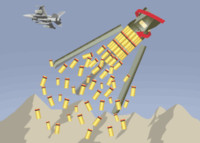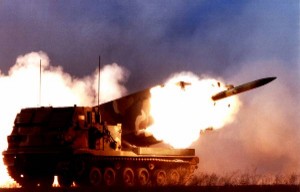- Background
- How cluster munitions work
- Multiple Launch Rocket System (MLRS)
- Cluster munitions and their effects in Lebanon
- Action against cluster munitions, and post-war developments
Background
- "34-day war" in Lebanon and northern Israel (July 12 to August 14, 2006)
- Israeli government vs. Hezbollah, a Lebanon-based Islamic militant group
- Ended with a U.N.-mediated ceasefire on August 14, 2006
- Israel used cluster bombs in Lebanon and there are allegations Hezbollah used cluster bombs in Israel
- Cluster bombs were used in many wars before this, including in Afghanistan, Iraq, Kosovo and Vietnam, as well as previous conflicts in Lebanon
 How Cluster Munitions Work
How Cluster Munitions Work
- Small bomblets called submunitions released from larger cluster munition; these submunitions are designed to explode, maim and kill as they scatter across a target area from the air and hit the ground
- Developed by the Germans in World War II to increase efficiency of aerial attacks against "soft" targets (personnel), first one called the "butterfly bomb"
- Unguided munitions deployed by aircraft, rocket launcher or artillery and containing--depending on type--anywhere from three to over 2,000 submunitions.
- Wide area of effect (about that of two football fields)
- Almost always leave behind unexploded submunitions, 2-40 percent failure rate (range and variations due to factors such as type and age of munition, environmental conditions, deployment technique and testing conditions)
- Different kinds of cluster munitions are produced today by about 30 countries.
 Multiple Launch Rocket System (MLRS)
Multiple Launch Rocket System (MLRS)
- Multiple Launch Rocket Systems were used in the 2006 Israel-Hezbollah conflict
- One of the most lethal missile launch systems; can deploy high numbers of cluster munitions very quickly, spreading submunitions over a large area
- Track- or tire-carried mobile rocket-launching platform with 12 rockets
- Can send rockets up to 20 miles away. In one minute, 12 M26 rockets can be fired, each containing 644 M77 submunitions (U.S.)
- Total = 7,728 submunitions in one minute.
- Reported failure rates for M77 submunitions range from 5 to 23 percent, which means hundreds or thousands of potential duds left after every MLRS launched.
Cluster munitions and their effects in Lebanon
Most of the submunitions were dropped in final 72 hours of conflict "when we knew there would be an end" according to Jan Egeland, U.N. Under-Secretary-General of Humanitarian Affairs (U.N News Centre) and include M77 (U.S.), M42 (U.S.), M46 (U.S.), M85 (Israel) and BLU-63 (U.S.) submunitions (Human Rights Watch, The New York Times).
It is estimated that up to four million submunitions may have been dropped and scattered (Handicap International).
Over 830 cluster munition strike sites with up to one million unexploded submunitions are estimated, covering over 34 million square meters (8,400 acres) as of January 8, 2006 (United Nations Mine Action Coordination Centre-South Lebanon).
Up to 200,000 displaced Lebanese cannot return due to danger from UXO as of November 1, 2006 according to the United Nations High Commissioner for Refugees (IRINnews.org). Between August 6 and January 7, 2006, 27 people died (six of them under the age of 18) and 179 others were wounded (57 under 18) by unexploded submunitions since the end of the 34-day conflict (United Nations Mine Action Coordination Centre-South Lebanon).
Clearance of unexploded ordnance and submunitions is estimated by the UNMACC-SL to take anywhere between 12 and 15 months (United Nations Mine Action Coordination Centre-South Lebanon).
Action against cluster munitions, and post-war developments
Convention on Certain Conventional Weapons (CCW), Protocol V: international law regarding post-conflict clean-up of unexploded ordnance and abandoned explosive ordnance (covers ERW other than landmines and booby traps, which are covered by Amended Protocol II); suggests voluntary preventive measures. Protocol V came into force November 12, 2006.
Discussions continue on further steps to take in order to restrict use of cluster munitions and decrease failure (dud) rates. The Third CCW Review Conference was held November 7-17, 2006, and during that time efforts were made to address cluster munitions and the threat unexploded submunitions hold for civilians. The conference failed to reach a deal to restrict the use of cluster munitions, instead agreeing only to keep talking about the issue (United Nations Office at Geneva).
After failing to reach an agreement within the framework of the CCW, civil society activists and countries (led by Norway) have called for a new international treaty separate from the CCW that would control or ban cluster munitions (Human Rights Watch).
Two U.S. senators, Dianne Feinstein (D-CA) and Patrick Leahy (D-VT), tried to stop U.S. production of cluster bombs, but the measure was defeated on September 6, 2006, by a vote of 70-30 (Washington Times).
Lebanon's National Demining Office in partnership with the Mine Action Coordination Centre of South Lebanon is collecting information and coordinating the response to cluster munitions.
Continued clean-up by many individuals and organizations including the Lebanese Army, United Nations Interim Forces in Lebanon, and groups contracted under the United Nations Mine Action Service: MAG, Swedish Rescue Services Agency, and BACTEC.
UNICEF is supporting the National Demining Office to implement mine risk education. Along with many other donors, USAID humanitarian assistance to Lebanon is being provided.
